The Power of Building Trust: How to Create Lifelong Customers through the Buyer's Journey
Welcome to the world of customer relationships; where building trust with your customers is the most important aspect of growing a successful business. After all, without customers your business wouldn't exist.
Discover the key stages of the buyer's journey and gain valuable insights into your customers' behavior by watching our Buyer's Journey Video here:
Building Trust with Customers is Key to Growing a Successful Business
"So how do you build trust?" You might ask. Good question! You build it by leveraging
The Buyer's Journey. 
Once the concept clicks, it will redefine your entire communication strategy and you'll quickly start to see radical differences in your customer conversations. Ultimately it will lead to more customers, who spend more, and who stay loyal for longer.
So what is it? Well, the
buyer’s journey is like a psychological map of how humans build trust with your brand.
It depicts the mental phases that each person goes through when interacting with your brand, from before they know you exist, all the way through to being a lifelong customer.
It's Just Like a Real Relationship
The best way to think of it is like building a relationship with another person. It's not something that can be rushed, and the relationship goes through distinct phases before you fall in love and want to get married. What the other person says and does makes a big difference to your level of trust with them. If they say and do the right things, the level of comfort & trust you feel in their company improves over time. If they try to move faster than you're comfortable with, your protective walls go up and you back away.
When you build relationships with your customers it's exactly the same.
What you say and when you say it, matters. Ask them for too much too soon, and they'll back away. Betray their trust just once and they'll never trust you again (think asking for meetings on the first LinkedIn message, or unsolicited emails trying to sell them something).
Instead, think about how you'd approach a real person who you want to build a relationship with. You'd want every interaction to be positive. Filled with value so that they crave the next meet up. Do that, and soon enough you'll be nudging them forward inch by inch, slowly forming trust and building that relationship from the ground up.


That's how you generate a life-long customer; because you’ve built a solid relationship with trust as the foundation, so it's built to last.
Leveraging the Buyer's Journey to Improve Customer Relationships
To apply this practically for your business, it means drip-feeding value at every step & ensuring that every touch point gives them a positive experience. Gradually make them realise how much they will benefit from this relationship. Getting them to truly understand your value is really important, because the higher they perceive your value, the more they will desire your solution. The more they desire it, the more they'll be willing to pay for it.
In other words, building strong relationships with your audience by drip-feeding them value, leads to more leads, greater desire for your solutions, and higher average spend. By increasing trust and loyalty, you also improve customer lifespans and increase the number of times they buy from you.
Can you see how this directly and positively impacts revenue?
The Importance of Understanding Your Value to Customers
If you don't know what your customers truly value, how will you communicate that to your audience? It's surprisingly difficult to understand what customers value when you're looking at it from the inside out. Here are some tips to help you identify it:
- Look closely at customer reviews & testimonials to pick out which parts of your product or service they talk about positively.
- Ask your customers explicitly what they find most valuable and why they stick around.
- Engage outside consultants with expertise in brand perception and psychology. They'll be able to quickly identify what your customers are actually buying from you, and it's probably not what you think. For example, a company selling leads isn't actually selling leads; they're selling the promise of business growth or business survival.
- 95% of decisions are emotionally led, which means that the emotion you make people feel (either now, or aspirationally) is what they value. See if you can identify what those emotions are and how to amplify them.
Peaking Interest Without Asking for a Commitment
So let's break it down and start at the beginning. This is when they first become aware of your existence.

At this point, they have no trust nor relationship with your brand. They barely know anything about you. Your main objective here is to peak their interest so that they are open to knowing more in the future.
A mistake brands often make at this stage is asking them to buy. Doing so is like asking for marriage on the first date. Don’t make this mistake. Our job here is to peak interest and nothing more.
If you do that successfully, you’ll have a person who is open to seeing your communications, but not ready to make a commitment. At this stage they are much more comfortable hiding in the shadows and observing, and don’t want to be approached. This is due to many reasons; for example they may not be ready to buy. They may not even know they need what you’re offering. And they haven’t had enough time to build a relationship with your brand yet. So approaching them at this point would be like going up to a stranger on the street and asking them to buy from you. It’s unlikely to work.

Our job at this point is to provide information and value to them, to start to gain their trust, and to show them why they might need our solution. This can’t be rushed - it’s a psychological process that each person must go through at their own pace.
Hmm, Interesting - But No
Once they realise they have a need for your solutions, that’s when they start to become a bit more active and open to non-commital communication. But this still doesn't mean you should rush in and force a meeting. Don't try to skip the steps or you'll raise those walls.

They may ask questions or interact with your posts. They've realised that you might have something of value to them. But they aren’t ready to buy yet.
What happens next often trips people up.
You’d think that as soon as someone realises they have a need, they’ll call you up and want to engage. But in reality, there’s a step that comes before that, and that’s Research.
The Phase Everyone Neglects
Here they will go to Google, and search for alternative solutions. Free solutions or cheaper solutions. They will educate themselves on the problem in order to know how best to solve it.
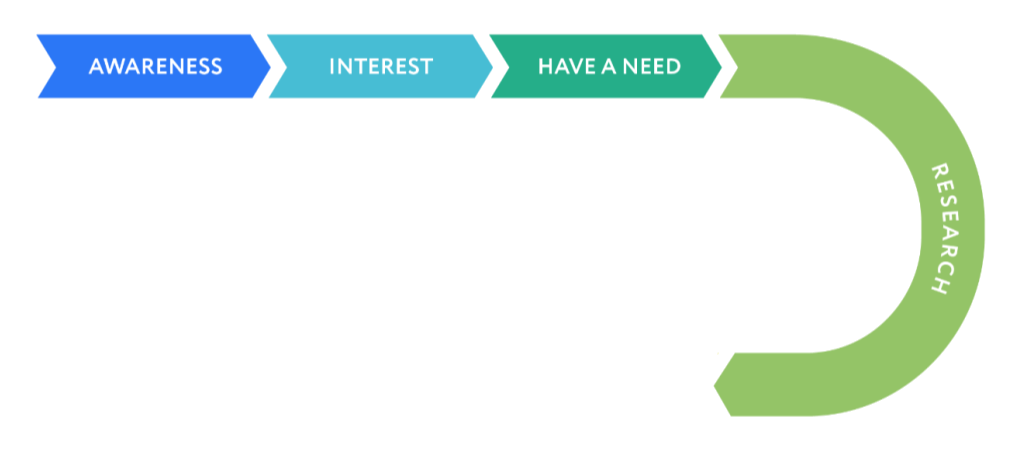
Here most brands make a big mistake. They leave these buyers to draw their own conclusions which may or may not include you. What if, instead, you could support their research? You could provide them with an in-depth list of alternative solutions, and explain the pros and cons of each. In doing so, you feed their thirst for knowledge and actually begin the pre-qualification process. Those who don’t find your solution to be ideal, won’t then waste your sales team’s time. Whereas those who do find it ideal, will be even more eager to speak with you. There are many other ways you can support the research phase. Suffice to say, don’t leave them to their own devices. Control the narrative, and ensure you’re the brand that’s guiding them through the process, because when the time comes for them to make a decision between you and a competitor; if you’ve been helping them all along, who do you think they’ll choose?
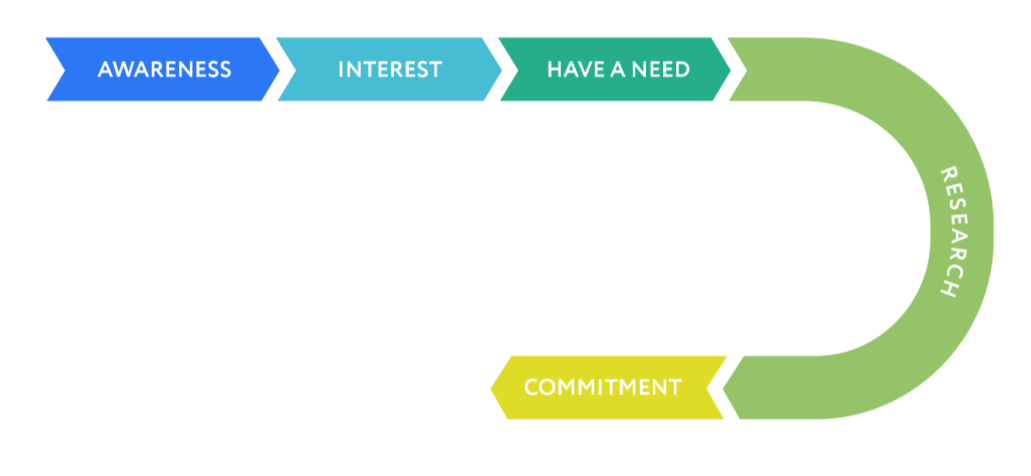
It's Time to Pop the Question
So you’ve been omnipresent throughout their journey this far and every interaction they’ve had with your brand has been positive and filled with value. Good job! That means you have stacked the odds firmly in your favour now it comes to making a decision.
You can now, finally, ask them for something. Typically this would be along the lines of "get in touch to see how we can support your business" - note how we're keeping the ball in their court, and always encouraging them with the incentives of additional value.
Having built strong relationships up to this point, you'll find that leads are warmer, they are better educated, and they are ready to proceed. Your sales team will become order takers rather than having to start the relationship from scratch every time.
This is Only the Beginning!
Congratulations - you've won a new customer! Exciting times! Let's not mess it up. You must now meet their expectations in your delivery. Have you over-promised something? Big mistake. Remember how I said if you betray their trust, they'll never trust you again? Don't do that. Remember that we're playing the long game here. So make sure all the promises you make are genuine and you're confident that the customer's expectations are realistic. You might want to have a chat with your sales team about this too!
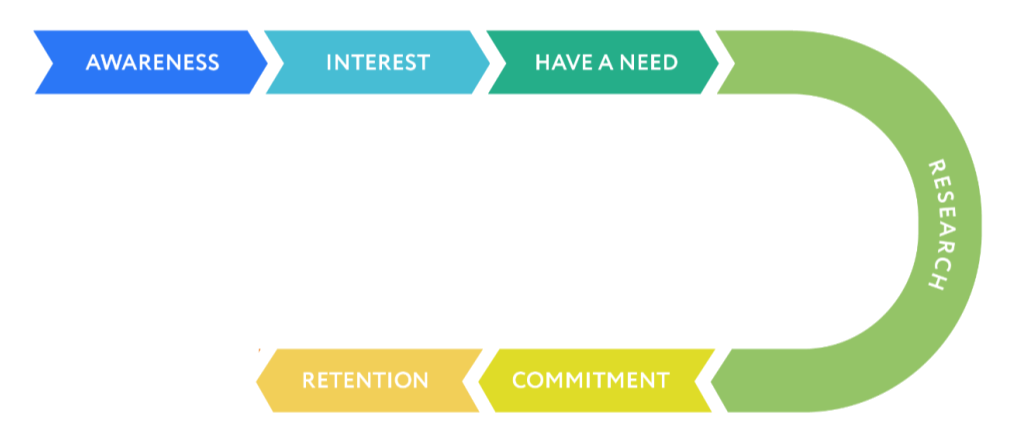
Once they become a customer, the relationship is only really getting started. Hopefully this will last a lifetime - and think therefore how much value that customer has to your business.
Often this is where brands stop trying. "We've won the customer - now let's win another!" But consider the fact that on average,
a customer's lifetime value is 10X greater than their first transaction. To neglect them now would be a big mistake. Especially after all that time, effort and money invested to acquire them.
A Relationship That Lasts a Lifetime
So how can you keep the relationship going? Client-centric Marketing. You must stay front-of-mind, continue to provide value, and raise awareness of your wider solutions.
Remember, there's always a competitor in the background nipping at your customer's toes, trying to win them over. So don't rest on your laurels - you have to make that relationship impenetrable and Foster loyalty.
Another great strategy is to check in with them regularly and ask them for feedback. This presents an excellent opportunity to capitalise on your happy customers, when you ask them to write a review or refer you to someone else. This will boost your most powerful marketing channel of all; word of mouth.
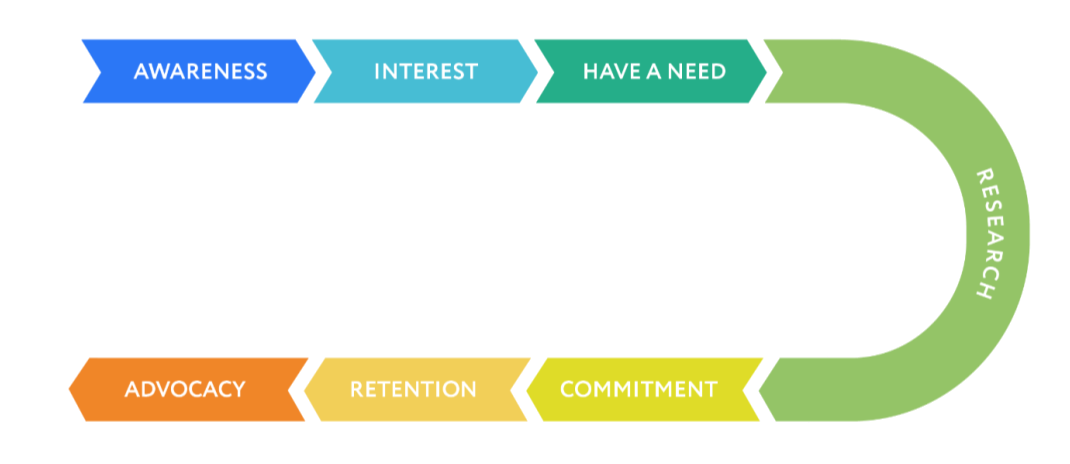
We Believe What We Say
Did you know that asking your customers for reviews, testimonials or referrals actually cements their views even further? That's because society highly values people who are consistent. If we say or write something to our peers, we psychologically want to see ourselves as consistent and therefore we must believe what we say. In doing so, we cement our beliefs. So if a customer writes about how great your business is, they will go out of their way to continue to see that greatness in you and therefore their loyalty instinctively increases. So definitely ask!
Familiarity or Trust? Your Brain Can't Tell the Difference
Layered throughout this journey are the various channels we can use to communicate to your audience. If you use these channels strategically, you can identify which stage of the journey they are in and therefore what you need to say.
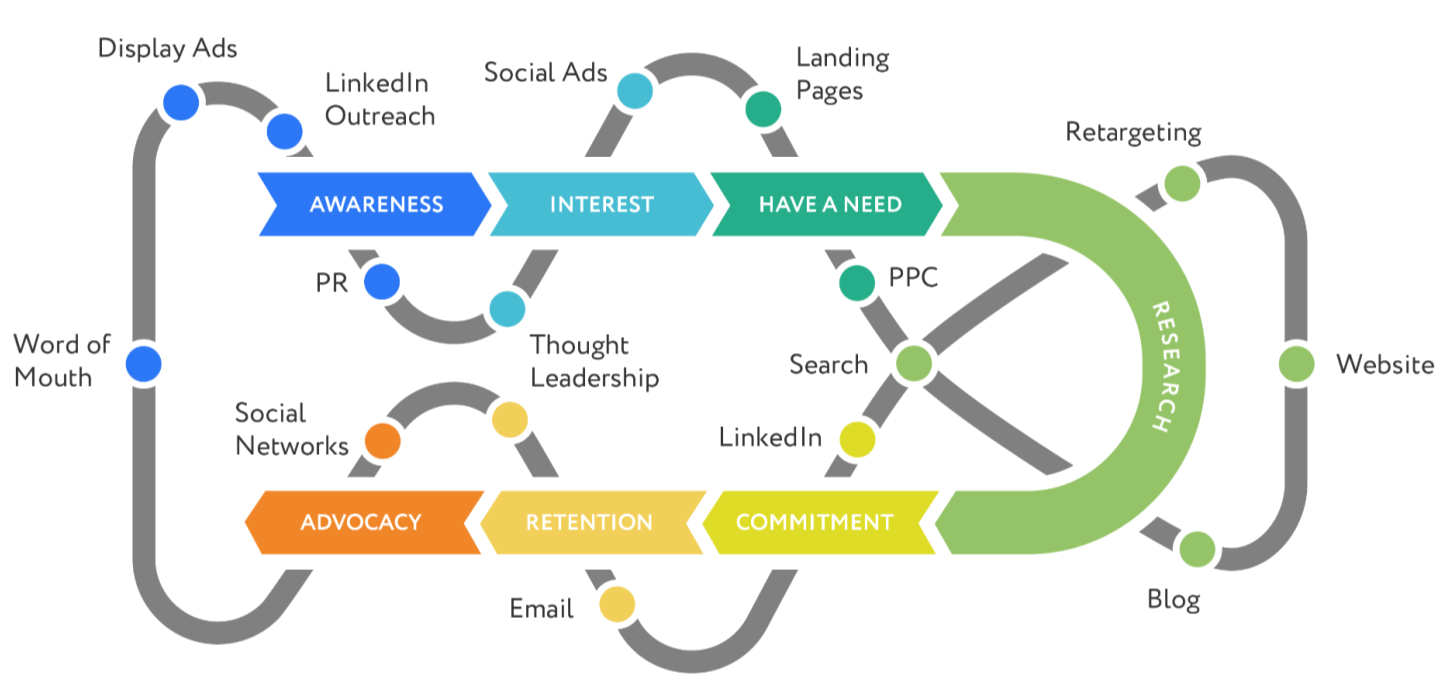
All these channels create touch-points which act to create familiarity with your brand. The mind cannot tell the difference between familiarity and trust. There's a reason why the word "familiar" comes from the word "family"! Therefore, simply by leveraging multiple channels and increasing the number of touch-points, you will inevitably increase familiarity and therefore trust with your brand.
It takes 7 touch points on average to build sufficient trust to enquire, so think about how you can use channels like these to achieve that. Remember: For each of those touch points, ensure that you add value, and use psychological techniques to increase their effectiveness. By combining multiple channels you can reach your audience wherever they go.
Working Smarter Not Harder
Did you know that many channels work synergistically which means you can yield even greater results with a similar level of effort?
For example, generating a new connection on LinkedIn enables you to acquire their email address. That email address can then receive email marketing, which sends them to your website. Once on your website, you can use remarketing to show your ads to them on social media. That journey creates a minimum of four touch points instead of just one, had you only connected on LinkedIn. Factor in the multiple touch points created from remarketing (when the ad displays more than once) and you're closing in on the vital 7!
Another example is when you produce content for thought leadership that’s placed on your blog. That content can be used as justification for an email, a LinkedIn post, and a YouTube video - all of which act to further increase touch points and authority. Furthermore, you support SEO with the additional content on your website and additional links around the web.
How Building Trust Directly Impacts Revenue
So that is how we approach The Buyer’s Journey from a strategic perspective, where every channel has a purpose, and supports the other channels around it.
Communication at every phase is carefully crafted to nudge them along the trust-building journey, so you end up with far more leads, who are hotter and ready to engage. Those leads see more value in what you do, so they are willing to pay more. When you nurture the relationship after the sale, they increase their loyalty towards your brand, which increases customer lifespans, and lifetime value. It naturally leads to more referrals and the whole cycle repeats.
If you had more leads and more customers, who spent more, and bought more frequently, what do you think that would do to your revenue?

 Once the concept clicks, it will redefine your entire communication strategy and you'll quickly start to see radical differences in your customer conversations. Ultimately it will lead to more customers, who spend more, and who stay loyal for longer.
Once the concept clicks, it will redefine your entire communication strategy and you'll quickly start to see radical differences in your customer conversations. Ultimately it will lead to more customers, who spend more, and who stay loyal for longer.









